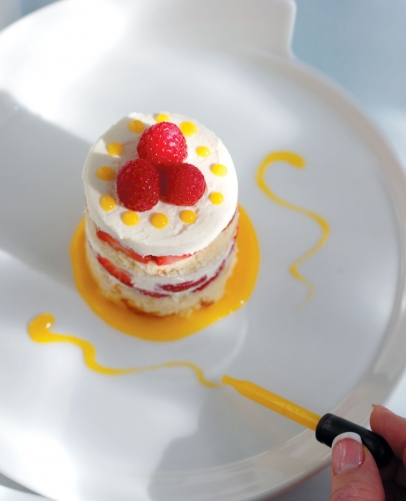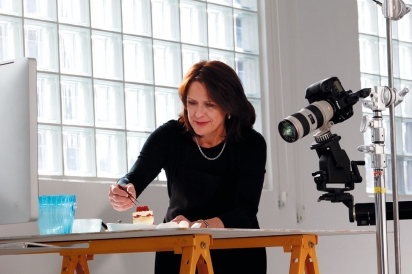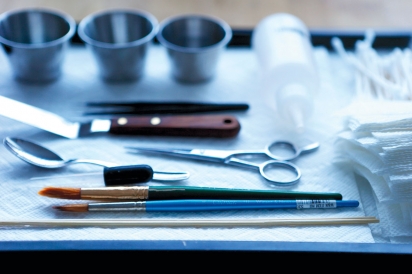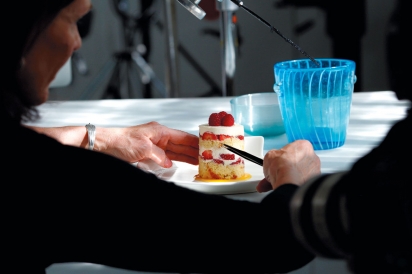Meet Rebecca Robison: A Glimpse at the Meticulous Life of a Food Stylist
Have you ever wondered how food photos splashed across websites and brochures for companies like Agri Beef and Albertsons became so droolworthy? It’s not because the food is made of plastic or coated in hairspray, it’s thanks to talented food stylists like Rebecca Robison.
“Food stylist” is a glamorous-sounding occupation, but in reality it’s comprised of meticulous work and long days. When a food stylist is on set, there are often clients, art directors and photographers looking over their shoulders the whole day.
I’m an art director for Foerstel Design, and Robison and I collaborated on a busy three-day shoot for Idahoan Foods where we cranked out 20 mashed potato dishes as part of a new campaign. This not only involved coming up with recipe ideas, shopping for ingredients, cooking and styling the food, but also working together to pick out backgrounds, plates, napkins and any other props.
After the shoot, I sat down with Robison and asked her a few questions about her interesting occupation.
I don’t know if most people even realize that being a food stylist is a career. What is food styling?
Food styling is really the art of preparing food for video or film.
And how did you choose this career?
I planned on getting a graphic design degree but when we moved to Boise I discovered there was a need for a food stylist here. I loved the idea of combining my art background with the culinary aspect.
What kind of training do you have?
I went to Culinary Arts and Services in Chicago and Tante Marie’s Cooking School in San Francisco. I’ve also attended a biannual convention, Food on Film, that’s full of workshops taught by food scientists, chefs and photographers, as well as technique classes on getting the perfect cheese melt, for example, or a chocolate seminar teaching the art of the swirl.
And how long have you been doing this?
27 years.
What do you think is the biggest misconception about food styling?
That we use plastic food, or that our only job is spraying food with water to keep it fresh looking. It’s a bit more technical than that. Whatever we are selling has to be the real thing as part of the Truth in Advertising Act.
So what are some tricks of the trade?
There are so many! Tweezers, torches, a heating element that makes marks for that “fresh from the grill” look or dusting charcoal with flour in a BBQ shot so they appear hot without actually having a fire in the studio. Foods like steak are often undercooked because it can turn dark when exposed to lights. Paper towels can be frozen and shaped over bowls to keep salads looking fresh. Slices of cheese are melted in warm water right on the set to drape over a hamburger to appear melty without heating everything else in the process—wilted lettuce does not look good on a burger! We are constantly deconstructing and reconstructing food.
What is the hardest food to style?
Hands down: ice cream. It takes hours of prep prior to a shoot and requires lots of dry ice, a cold studio, extra freezers, precision timing, a lot of technique and most of all, patience.
I imagine it’s important to stay current on what is contemporary and trending in the food industry. What’s one of your favorite sources of inspiration?
The Australian food magazine Donna Hay. There is great attention to detail in food styling, propping and set design, and since their seasons are opposite it gives me time to percolate ideas for our coming season.
Any advice for budding food stylists?
Having culinary skills and an understanding of the science behind food is essential. Develop a keen eye for composition, color and detail as well as the ability to create artful food presentations. If you can begin as an assistant for an already established food stylist, that’s perfect.
What is the most fun part of your job?
[Laughing] I get paid to shop! I also really like coming up with the creative set design and props that enhance a recipe. It’s the small details that really make the photograph, so I am always on the lookout for interesting flatware, cutting boards, plates, etc. It’s also really satisfying having something beautiful that you’ve worked on for hours captured on film.
Find out more about Robison, along with recipes and behind the scenes shots, at StylishFork.com.
Linda Whittig, in addition to being the art director for Foerstel Design, does a little of her own food styling for BistroOneSix.com and can be found eating and drinking around Boise with her husband.







